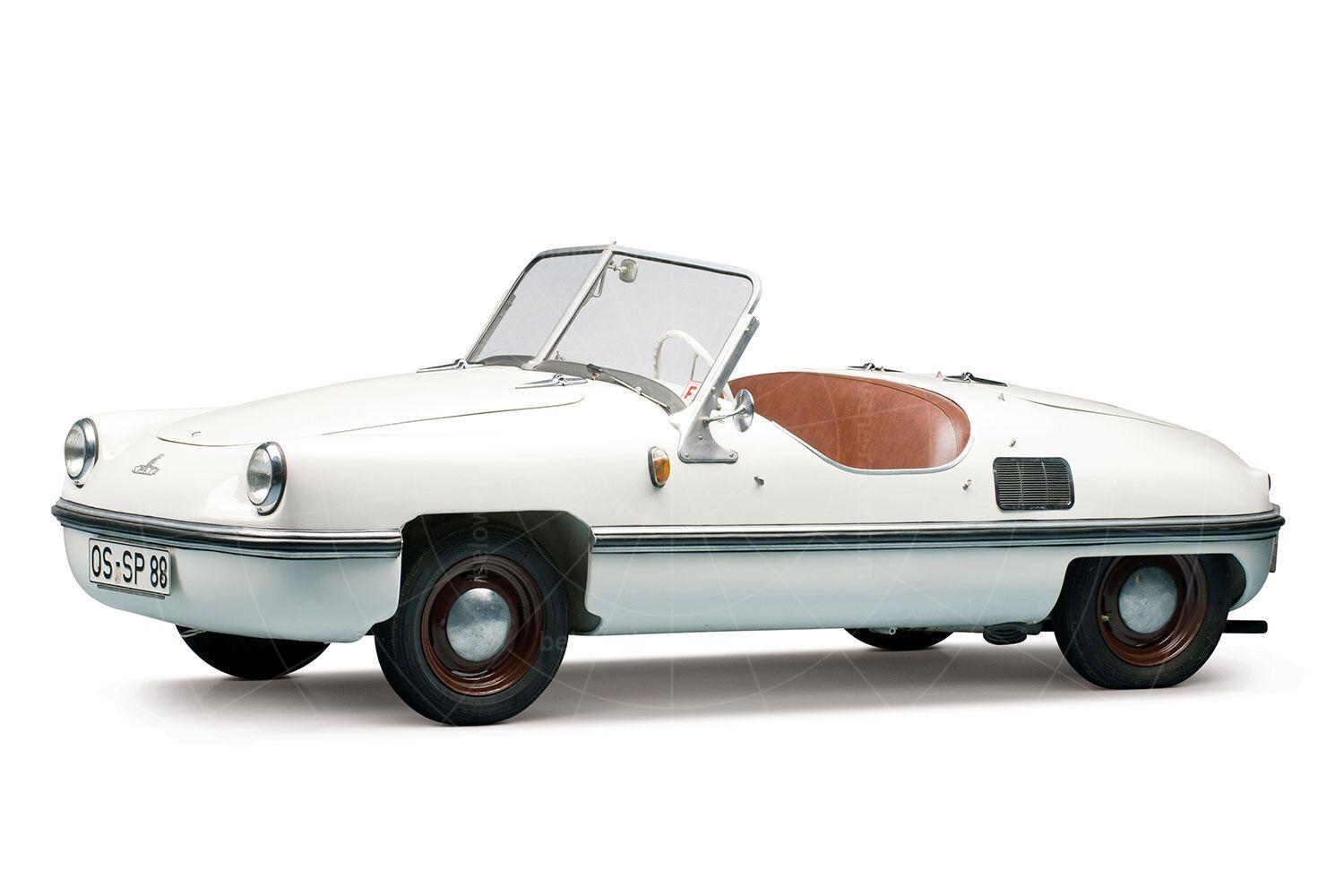When it comes to prolific car designers, few could keep up with Egon Brutsch who produced one tiny car after another. Between 1952 and 1958 he came up with no fewer than 11 of them (including the Mopetta), but he made hardly any cars at all. Instead he relied on selling licences for his various vehicles, which were usually made of plastic, featured tiny engines and were very much at the economy end of the scale.
At the 1954 Paris Salon, Brutsch introduced the three-wheeled 200 Spatz (Sparrow), powered by a 191cc Fichtel & Sachs air-cooled single-cylinder engine. Crucially, the new car featured a glassfibre monocoque and the lack of a separate chassis would lead to problems aplenty later on.
Harald Friedrich, the co-owner of machine tool manufacturer Alzmetall, was thinking of expanding his portfolio by investing in presses for the plastics that were becoming increasingly common in the mid-1950s. He met the charismatic Egon Brütsch at that Paris show, and Brutsch impressed on Friedrich that plastics were indeed the future.
Brütsch delivered a car and a set of plans, and Friedrich couldn’t believe his luck that not only was he now making car parts, but he was in a position to offer complete vehicles. In December 1954 Brutsch agreed to make and sell his own version of Brutsch's 200 Spatz.
In spring 1955 Friedrich was able to thoroughly test drive the 200 Spatz, and as a result of this he agreed to enter into a licence agreement on the titchy three-wheeler, which would be marketed as the Spatz (Sparrow). However, after driving the Spatz on poor-quality rural roads Friedrich soon discovered that the glassfibre bodyshell developed serious cracks in the suspension mountings which rendered the car completely unsafe and unsaleable, and Brütsch wouldn't enter into any correspondence to put things right.
Adamant that he wouldn't be defeated, Friedrich commissioned Hans Ledwinka to make a proper car out of the Spatz. The 77-year old Ledwinka was best known for his work designing Tatras, and it was from this work that he created a superb backbone frame.
Moving to four wheels was not so difficult a conversion, and so evolved the Spatz. Hydraulic brakes were a given, with a 7.1-inch drum at each corner, and the engine sat ahead of the back wheels, making it a well-balanced rear-engined car. The faired-in headlights were replaced by conventional items and the now split-windscreen acquired a sturdy frame for better sealing with the fabric roof.
There was independent suspension all round. Up front there were trailing arms with co-axial coil spring and hydraulic damper units, while at the back there were swing axles with radius arms and co-axial coil spring and hydraulic damper units.
Friedrich knew the single-cylinder two-stroke 191cc Fichtel & Sachs engine was barely up to the job; the Spatz's kerb weight was 705lb (320kg) and the maximum payload was 530lb (240kg). But a replacement was unavailable as BMW’s Isetta unit was not for sale, so Friedrich had to persevere with Brutsch's original unit.
The totally revamped car made its debut in September 1955 and in standard form there were no doors and just a rudimentary soft top to keep the elements out. The plan was to offer a removable hard top with gull-wing doors, but the design for such a configuration had already been taken out by Hans Trippel (of Amphicar fame), and as a result only the one prototype was ever made.
The bench seat was designed to take three occupants at a pinch, in the nose there was a small boot, while all around the car a hard rubber insert was fitted, dodgem car-like, to protect the Spatz from minor bumps and knocks.
Friedrich formed the Spatz-Fahrzeugbau company to build his new economy car, and he also found time to build presses that cured the bodyshells in seven minutes instead of 24 hours. Production got under way in February 1956, then in July of the same year he signed a partnership agreement with Nürnberg-based motorcycle manufacturer Victoria (established in 1899), which gave him an instant dealer network. The new company was called BAG (Bayerische Auto-Gesellschaft, or Bavarian Auto Works).
At last, after a huge amount of effort, things were starting to go Friedrich's way, but Egon Brutsch then threw a spanner into the works by taking legal action for the licence fees that he felt he was owed for sales of 'his' car – even though the only remaining elements were the Spatz name and the 191cc engine. Brutsch lost his case but Friedrich had had enough and he decided to walk away from the partnership, with Spatz production lasting all of 15 months as a result. But that wasn't the end of the story as the Spatz would continue in production as the Victoria 250 before having a final lease of life as the Burgfalke FB250.
| Vital statistics | |
|---|---|
| Produced | 1956-1957, Germany |
| Number built | 859 |
| Engine | Rear-mounted, 191cc, 1-cylinder |
| Transmission | 4-speed manual, rear-wheel drive |
| Power | 10bhp |
| Top speed | 50mph |
- The BAG Spatz pictured was sold by RM Sotheby's for $32,200 in 2013. Many thanks to RM Sotheby's for the use of its pictures to illustrate this article.





















